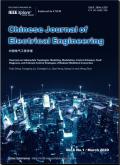Biological Hydrogen Production: A Comprehensive Review for Converting Wastes into Wealth
IF 3.5
Q1 Engineering
引用次数: 0
Abstract
Energy shortages have hindered global economic development. By utilizing waste as a substrate for microbial fermentation, hydrogen production can transform waste into a valuable resource, significantly reducing the cost of hydrogen production and addressing a significant hurdle in achieving large-scale production of microbial hydrogen. This approach has significant potential for future hydrogen-production applications. Two-stage indirect photohydrolysis has recently emerged as a promising and efficient method for hydrogen production using cyanobacteria and green algae. However, this method cannot be directly applied to organic wastewater for hydrogen production. In contrast, dark fermentation by bacteria, particularly ethanol-type fermentation, is highly efficient for producing hydrogen. Therefore, the combination of the indirect photohydrolysis of algae and dark fermentation by bacteria is expected to significantly enhance the hydrogen-production capacity of organic wastewater, laying the groundwork for future large-scale microbial hydrogen production. This study reviews the main types and technical principles of microbial hydrogen production from waste, available waste types, research progress in the microbial hydrogen-production process, strategies to improve the hydrogen-production rate, and challenges faced during industrialization. Future research directions for microbial-waste hydrogen production are also proposed. The aim of this study is to provide a valuable reference for large-scale biological hydrogen-production research.生物制氢:将废物转化为财富的全面回顾
能源短缺阻碍了全球经济发展。通过利用废物作为微生物发酵的底物,制氢可以将废物转化为宝贵的资源,大大降低制氢成本,并解决实现大规模微生物制氢的重大障碍。这种方法在未来的制氢应用中具有巨大潜力。最近出现的两阶段间接光水解法是利用蓝藻和绿藻制氢的一种前景广阔的高效方法。然而,这种方法不能直接用于有机废水的制氢。相比之下,细菌的暗发酵,特别是乙醇型发酵,制氢效率很高。因此,藻类间接光水解与细菌暗发酵相结合,有望显著提高有机废水的制氢能力,为未来大规模微生物制氢奠定基础。本研究综述了废物微生物制氢的主要类型和技术原理、可利用的废物类型、微生物制氢工艺的研究进展、提高制氢率的策略以及产业化过程中面临的挑战。此外,还提出了微生物废物制氢的未来研究方向。本研究旨在为大规模生物制氢研究提供有价值的参考。
本文章由计算机程序翻译,如有差异,请以英文原文为准。
求助全文
约1分钟内获得全文
求助全文
来源期刊

Chinese Journal of Electrical Engineering
Energy-Energy Engineering and Power Technology
CiteScore
7.80
自引率
0.00%
发文量
621
审稿时长
12 weeks
 求助内容:
求助内容: 应助结果提醒方式:
应助结果提醒方式:


